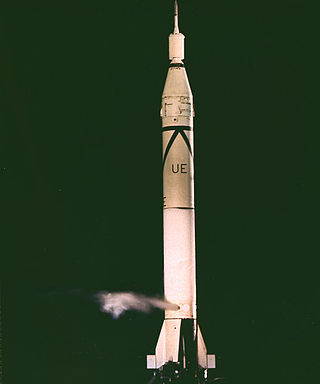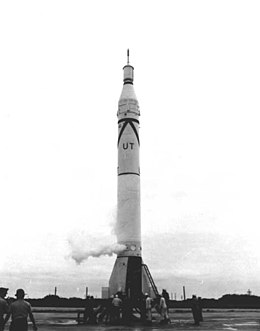
Explorer 1 was the first satellite launched by the United States in 1958 and was part of the U.S. participation in the International Geophysical Year (IGY). The mission followed the first two satellites, both launched by the Soviet Union during the previous year, Sputnik 1 and Sputnik 2. This began a Space Race during the Cold War between the two nations.

The Jupiter-C was an American research and development vehicle developed from the Jupiter-A. Jupiter-C was used for three uncrewed sub-orbital spaceflights in 1956 and 1957 to test re-entry nosecones that were later to be deployed on the more advanced PGM-19 Jupiter mobile missile. The recovered nosecone was displayed in the Oval Office as part of President Dwight D. Eisenhower's televised speech on November 7, 1957.

The Juno I was a four-stage American space launch vehicle, used to launch lightweight payloads into low Earth orbit. The launch vehicle was used between January 1958 to December 1959. The launch vehicle is a member of the Redstone launch vehicle family, and was derived from the Jupiter-C sounding rocket. It is commonly confused with the Juno II launch vehicle, which was derived from the PGM-19 Jupiter medium-range ballistic missile. In 1958, a Juno I launch vehicle was used to launch America's first satellite, Explorer 1.

Vanguard TV-3, was the first attempt of the United States to launch a satellite into orbit around the Earth, after the successful Soviet launches of Sputnik 1 and Sputnik 2. Vanguard TV-3 was a small satellite designed to test the launch capabilities of the three-stage Vanguard and study the effects of the environment on a satellite and its systems in Earth orbit. It was also to be used to obtain geodetic measurements through orbit analysis. Solar cells on Vanguard TV-3 were manufactured by Bell Laboratories.

Vanguard 1 is an American satellite that was the fourth artificial Earth-orbiting satellite to be successfully launched, following Sputnik 1, Sputnik 2, and Explorer 1. It was launched 17 March 1958. Vanguard 1 was the first satellite to have solar electric power. Although communications with the satellite were lost in 1964, it remains the oldest human-made object still in orbit, together with the upper stage of its launch vehicle.
Project Vanguard was a program managed by the United States Navy Naval Research Laboratory (NRL), which intended to launch the first artificial satellite into low Earth orbit using a Vanguard rocket. as the launch vehicle from Cape Canaveral Missile Annex, Florida.

The Army Ballistic Missile Agency (ABMA) was formed to develop the U.S. Army's first large ballistic missile. The agency was established at Redstone Arsenal on 1 February 1956, and commanded by Major General John B. Medaris with Wernher von Braun as technical director.

James Alfred Van Allen was an American space scientist at the University of Iowa. He was instrumental in establishing the field of magnetospheric research in space.

The Saturn family of American rockets was developed by a team of former German rocket engineers and scientists led by Wernher von Braun to launch heavy payloads to Earth orbit and beyond. The Saturn family used liquid hydrogen as fuel in the upper stages. Originally proposed as a military satellite launcher, they were adopted as the launch vehicles for the Apollo Moon program. Three versions were built and flown: the medium-lift Saturn I, the heavy-lift Saturn IB, and the super heavy-lift Saturn V.
Explorer 2 was an American unmanned space mission within the Explorer program. Intended to be a repetition of the previous Explorer 1 mission, which placed a satellite into medium Earth orbit, the spacecraft was unable to reach orbit due to a failure in the launch vehicle during launch.
The Vanguard rocket was intended to be the first launch vehicle the United States would use to place a satellite into orbit. Instead, the Sputnik crisis caused by the surprise launch of Sputnik 1 led the U.S., after the failure of Vanguard TV-3, to quickly orbit the Explorer 1 satellite using a Juno I rocket, making Vanguard 1 the second successful U.S. orbital launch.

SCORE was the world's first purpose-built communications satellite. Launched aboard an American Atlas rocket on December 18, 1958, SCORE provided the second test of a communications relay system in space, the first broadcast of a human voice from space, and the first successful use of the Atlas as a launch vehicle. It captured world attention by broadcasting a Christmas message via shortwave radio from U.S. President Dwight D. Eisenhower through an on-board tape recorder. The satellite was popularly dubbed "The Talking Atlas" as well as "Chatterbox". SCORE, as a geopolitical strategy, placed the United States at an even technological par with the Soviet Union as a highly functional response to the Sputnik 1 and Sputnik 2 satellites.

Milton William Rosen was a United States Navy engineer and project manager in the US space program between the end of World War II and the early days of the Apollo Program. He led development of the Viking and Vanguard rockets, and was influential in the critical decisions early in NASA's history that led to the definition of the Saturn rockets, which were central to the eventual success of the American Moon landing program. He died of prostate cancer in 2014.
The Redstone family of rockets consisted of a number of American ballistic missiles, sounding rockets and expendable launch vehicles operational during the 1950s and 1960s. The first member of the Redstone family was the PGM-11 Redstone missile, from which all subsequent variations of the Redstone were derived. The Juno 1 version of the Redstone launched Explorer 1, the first U.S. orbital satellite in 1958 and the Mercury-Redstone variation carried the first two U.S. astronauts into space in 1961. The rocket was named for the Redstone Arsenal in Huntsville, Alabama where it was developed.

Vanguard TV-3BU, also called Vanguard Test Vehicle-Three Backup, was the second flight of the American Vanguard rocket. An unsuccessful attempt to place an unnamed satellite, Vanguard 1B, into orbit, the rocket was launched on 5 February 1958. It was launched from LC-18A at the Cape Canaveral Air Force Station. Fifty-seven seconds after launch, control of the vehicle was lost, and it failed to achieve orbit. At 57 seconds, the booster suddenly pitched down. The skinny second stage broke in half from aerodynamic stress, causing the Vanguard to tumble end-over-end before a range safety officer sent the destruct command. The cause of the failure was attributed to a spurious guidance signal that caused the first stage to perform unintended pitch maneuvers. Vanguard TV-3BU only reached an altitude of 6.1 km (3.8 mi), the goal was 3,840 km (2,390 mi).

Vanguard TV-0, also called Vanguard Test Vehicle-Zero, was the first sub-orbital test flight of a Viking rocket as part of the Project Vanguard.

Vanguard TV-1, also called Vanguard Test Vehicle-One, was the second sub-orbital test flight of a Vanguard rocket as part of the Project Vanguard. Vanguard TV-1 followed the successful launch of Vanguard TV-0 a one-stage rocket launched in December 1956.

Vanguard SLV-3, also called Vanguard Satellite Launch Vehicle-3 hoped to be the second successful flight of the American Vanguard rocket following successful Vanguard 1 satellite on rocket Vanguard TV-4.

Explorer S-46 was a NASA satellite with a mass of 41 kg (90 lb). It was the last of the original series of Explorer satellites built, designed, and operated by the Jet Propulsion Laboratory and Army Ballistic Missile Agency (ABMA).

Beacon was one of America's first satellite programs. A balloon satellite, its objective was to study atmospheric density at its orbital altitude and to be the first United States satellite visible to the naked eye. Booster problems caused both orbital attempts to end in failure.

















